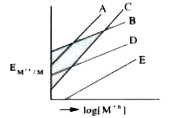In the following concentration cell
Ag(s)/AgCl(saturated)//AgNO3(aq)(0.1M)/Ag(s),KSP of AgCl=1×10−10 The cell potential will be Solution in Telugu
Ecell=0.295V
Ecell=0.236V
Ecell=0.0591log[Ag+]cathode√Ksp of AgCl
Ecell=E∘cell+0.0591log√KSP of AgCl[Ag+]cathode
The correct Answer is:B, C, D
E=0−0.05911log[Ag⊕]a[Ag⊕]c,E=−0.05911log10−510−1=−0.05911×(−4)=0.2364V
Topper's Solved these Questions
- BOOK - AAKASH SERIESCHAPTER - ELECTROCHEMISTRY EXERCISE - PRACTICE SHEET -5 (LINKED COMPREHENSION TYPE QUESTIONS (PASSAGE-I))3videos
ELECTROCHEMISTRY
- BOOK - AAKASH SERIESCHAPTER - ELECTROCHEMISTRY EXERCISE - PRACTICE SHEET -5 (LINKED COMPREHENSION TYPE QUESTIONS (PASSAGE-II))3videos
ELECTROCHEMISTRY
- BOOK - AAKASH SERIESCHAPTER - ELECTROCHEMISTRY EXERCISE - PRACTICE SHEET -4 (INTEGER ANSWER TYPE QUESTIONS )6videos
ELECTROCHEMISTRY
- BOOK - AAKASH SERIESCHAPTER - DILUTE SOLUTIONSEXERCISE - EXERCISE - 1.255videos
DILUTE SOLUTIONS
- BOOK - AAKASH SERIESCHAPTER - ELEMENTS OF D - BLOCKEXERCISE - EXERCISE - 5.233videos
ELEMENTS OF D - BLOCK
Similar Questions
Nernst equation gives the variation of potential of an electrode based on activity of ions temperature and pressure. The equation is
E=E∘−2.303RTnFlogQ(or)E=E∘−0.0591nlogQ
E∘= Standard potential and 'Q' is the reaction quotient.
What is the reduction potential of a hydrogen electrode in an aqueous solution containing 0.1 M NH4OH,(Kb=10−5), ?06:07View SolutionFor metal electrodes show the variation in their reduction potential as shown.

Which is the most reactive metal ?04:40View SolutionDuring electrolysis of one mole or aq HCOOK . How many moles of H2 is formed overall ?
03:46View SolutionWhat are the factor on-which solubility depends on ?
02:49View SolutionGive some examples for the ions with pseudo inert gas electronic configuration.
02:33View SolutionFor galvanic cell,
Ag|AgCl(s),CsCl(0.1M)|∣∣CsBr(10−3M),AgBr(s)∣∣Ag.
Calculate the EMF generated and assign correct polarity to each electrode for spontaneous or exergonic process at 25∘C.
Given ∴Ksp of AgCl=3.0×10−10,Ksp of AgBr=4.0×10−13.02:57View SolutionConsider the cell Ag(s)∣∣AgBr(s)Brc−(aq)∣∣∣∣AgCl(s),Clc−(aq)∣∣Ag(s) at 298K. The Ksp of AgBr and AgCl, respectively are 5×10−13 and 1×10−10 . At what ratio of [Brc−] and [Clc−] ions, EMFcell would be zero ?
01:51View SolutionConsider the electrode Ag|AgCl(s),Cl^(c-)(0.1M),i.e., silver electrode in contact with 0.1M KCl solution saturated with AgCl . If it is combined with the electrode Ag|Ag^(o+)(0.1M) to form a complete cell, the EMF would be (K_(sp)of AgCl=10^(10) at 25^(@)C)
View SolutionFor the cell (at 298K)
Ag(s)|AgCl(s)|Cl−(aq)∣|AgNO3(aq)|Ag(s)
Which of the following is correct?View SolutionFor the galvanic cell: Ag(s) | AgBr(aq) | Br^(-)(aq) || Cl^(-)(aq)| AgCl(s)| Ag(s) the value of E_(cell)^(@) at 298 K: [Given : K_(sp) of AgCl =2 xx 10^(-10) . K_(sp) of AgBr = 4 xx 10^(-13) = (2.303R xx 298)/(F) = 0.06 , log 2 = 0.3]
10:07View SolutionThe solubility of AgCl in 0.1M NaCI is (Ksp of AgCl=1.2×10−10)
04:05View SolutionAg/AgBr(s),KBr0.1M/KCl0.1M,AgCl(3)/Ag the cell potential is 0.1x volts. What is x ?
(KspAgBr=10−16,AgCl=10−11)03:46View SolutionKsp of AgCl at 25∘C is 1.782×10−10. At 35∘C,Ksp is 4.159xx10^(10).WˆareDeltaH^(0)andDeltaS^(0)forthereaction:AgCl(s)=Ag^(+)(aq)+Cl^(-)(aq) ?
01:27View SolutionIn 1 L saturated solution of AgCl [K_(sp) AgCl 1.6xx10^10] 0.1 mole of CuCl [K_(sp)(CuCl)1.0 10^6] is added. The resultant concentration of Ag in the solution is 1.6 10^x .
View SolutionFor galvanic cell,
Ag|AgCl(s),CsCl(0.1M)|∣∣CsBr(10−3M),AgBr(s)∣∣Ag.
Calculate the EMF generated and assign correct polarity to each electrode for spontaneous or exergonic process at 25∘C.
Given ∴Ksp of AgCl=3.0×10−10,Ksp of AgBr=4.0×10−13.05:00View Solution

